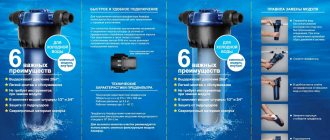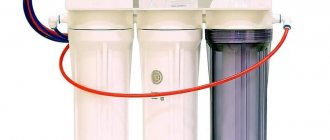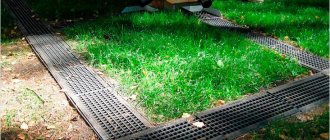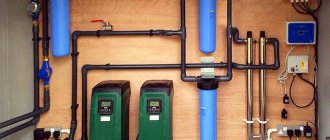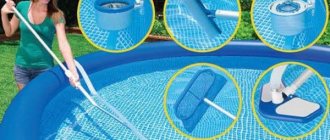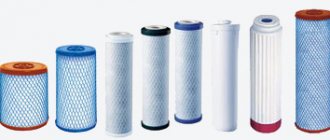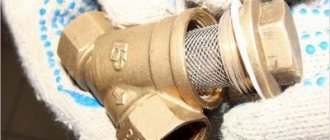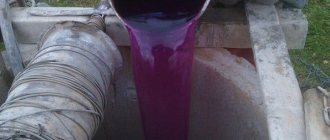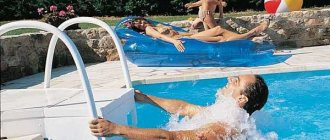28.04.2021
Well
Editorial staff of the “New Place” website
Share
From this article you will learn
:
- Characteristics of water from a well
- 6 stages of water purification from a well for a private home
- Installation of a water filter for a house from a well
- Types of filters for a private house for a well for primary cleaning
- What kind of water purification filter for a well can be installed at home
- Types of flow filters for additional purification of water coming from a well
- Subtleties of installing a filter for a well
- Criteria for choosing the best filter for well water
A well filter allows you to cope with most pollutants and impurities in the water entering your home. If in a centralized system it is prepared for delivery to the end consumer, for sources on the site this task falls on the shoulders of the owner. If you do not take care of cleaning, incoming well water can lead to damage to equipment (washing machines and dishwashers), failure of the water supply system, and even worsen health if the whole family is accustomed to drinking directly from the tap.
Even if the appearance of water from a well does not cause suspicion, this does not mean that there are no impurities in it. In most cases they are harmless, but there are also those that can cause a direct or indirect threat. In order not to risk the health of family members and save on equipment repairs, you need to take care in advance of purchasing and installing a filter for a well.
Characteristics of water from a well
The most significant problem that can arise when using a well is its contamination. The mine silts up and the quality of the water deteriorates to the point where it is undrinkable. It is also not always possible to use it for other purposes, or at least it is unpleasant, since it is full of impurities. It is quite difficult to purify such water. You won't be able to do this on your own. To do this, you need to have certain knowledge and an industrial filter; for water from a well, such a device is often unprofitable.
What may be contained in contaminated well water? There are many different elements:
- solid particles (sand, stones);
- iron salts;
- heavy metals;
- bacteria;
- hydrogen sulfide.
The underground layers contain little of the usual debris, and bacteria are also difficult to find. Much more often, metal salts, calcium, lime and other things are dissolved in such water. The liquid, passing through the rocks, collects a lot of everything that it encounters along the way.
In terms of purity, a well is the best source of drinking water compared to wells. The source is closed from the external environment and protected from the ingress of ordinary household waste and other biological contaminants. The chemical and microbiological composition of the fluid in the well is determined by the presence of nearby mineral rocks.
- The Abyssinian well reaches a depth of 8–12 m . The water contains few minerals and is usually clean. But it sometimes contains elements of the nitrogen group (nitrites, nitrates, ammonia), pesticides and other contaminants from the soil. At the microbiological level, things can be even worse. In some cases, it is recommended to buy a filter for an Abyssinian well.
- A well in sand goes down to a depth of 15–40 meters . Contaminants do not enter it from the surface, and it is not subject to mineralization, compared to artesian water. Sometimes such a well also contains dangerous microorganisms, organics and inorganic elements - calcium salts, iron salts, nitrogen group.
- An artesian well is deeper than all other sources . There are no microbiological elements in it, but often there are many minerals. Well water contains hardness salts (primarily calcium), hydrogen sulfide, inorganic iron and manganese. Some minerals are in unoxidized form and precipitate only after settling. Also, brown and black deposits form over time on plumbing fixtures and kettles.
Before using water from a well for drinking, you need to have its composition analyzed in a special laboratory.
The following indicators of water quality from the source are determined there:
- color;
- turbidity;
- general iron;
- general hardness;
- chlorides;
- nitrites, nitrates, ammonia;
- oxidability;
- alkalinity;
- pH;
- presence and concentration of microorganisms.
By determining the amount of all the listed elements, you can accurately identify problems with water and select an effective cleaning system, find out which filter is best for a well. Sometimes the presence of manganese and other specific elements is detected. When the water meets sanitary standards, then there is no need for water treatment.
You can understand that water from a well needs purification based on certain signs. The following phenomena are noticeable:
- Silt appears when there are decay processes. It is caused by a large volume of undesirable substances in the water.
- Water that contains a lot of metals gets a metallic taste. This worsens the quality characteristics of the liquid. They can be significantly improved if cleaned through filters.
- A yellow coating on dishes and plumbing appears when dissolved salts and a number of other elements are present in the water. They are deposited on surfaces, causing coloration.
- A cloudy sediment with the presence of sludge in small quantities occurs if harmful bacteria live in the water.
- The foul odor of rotten eggs is caused by the presence of hydrogen sulfide.
Installation of a water filter for a house from a well
To choose the right filter for purifying water from a well, you need to get acquainted with the principle of its design and operation. Well equipment solves the following problems:
- retains solid impurities in front of the casing pipe entrance;
- keeps the well from collapsing.
Downhole equipment includes:
- filters;
- perforated supports;
- settling tank
Each element can be made in several versions for functioning in different aquifers. The basis of the filter for the well pipe is perforated metal. The holes in it are oblong or round, 1-2 cm in size. Slot-like holes allow more water to pass through, but weaken the structure.
The perforation area should be 20–30% of the entire circumference of the pipe. The filter base and the well line are made of the same material, because their coupling must be airtight.
When using metal operating parts, the base must also be made of stainless steel. If plastic elements are used, the base must be selected from plastic, because metal and plastic will not create a hermetically sealed connection.
The filter layer should not fit tightly to the perforated pipe. To do this, create a frame of vertical rods or loosely wound wire around the filter. Make a gap of several millimeters between the turns.
In filter configurations for water intakes, there are several options for the filter layer:
- mesh;
- wire;
- combined.
For the first, the filter part is made of mesh, for the second, a wedge-shaped wire is used, which is wrapped around the filter body.
The most convenient option is a mesh filter. If damage occurs, only part of the filter requires replacement. High-quality metal construction can last up to fifty years. If you prefer high-quality water purification, you should buy a mesh filter for a well. Plastic filters are not strong enough and cannot withstand heavy loads. Compared to stainless steel, they have a shorter service life.
A wire filter is more durable because the material is thicker than mesh. The cost of such equipment is accordingly higher. When using galvanized wire, the maximum service life of the filter will be 7 years.
This is interesting!
Hydrogen sulfide in a well: what the threat is and what to do Read more
The size of the cells and their shape in mesh filters vary. They need to be selected depending on the size of solid particles found in the water after the analysis.
An additional filter layer of gravel is placed near the well pipe. Coarse sand and small smooth pebbles are also suitable for these purposes. They are a natural high-quality filter capable of self-cleaning.
When constructing a filter for a well, a formula with the exact parameters of the aquifer is used. Although builders usually focus on professional experience.
- With a casing pipe diameter of 10–15 cm, a one-meter high filter is required for sandy water horizons. The optimal size of the cleaning part is two meters.
- If there is too fine sand in the water, you need to make a filter for the well twice as high as usual. If sediment in the form of dust is present, six-meter equipment can be used if the aquifer depth is sufficient. Use a filter diameter that allows you to freely install the pump in the well.
When the source is already in operation, it will not be possible to change parts. Therefore, they immediately choose high-quality materials and elements that can last up to 30 years or more and do not require repairs.
How to minimize pollution?
Sand and lime may appear in the water due to the initial properties of the aquifer or errors during drilling or use of the well.
You can minimize the likelihood of well contamination with sand grains using a set of measures:
When drilling, you need to monitor the condition of the casing pipe.- The new well should be thoroughly flushed.
- A caisson and a cap should be made on top around the outlet hole.
- In sandy soils, vibrating pumps should not be used for pumping.
- Long pauses in work should not be allowed.
Important. It is impossible to completely eliminate the ingress of sand, but it will be possible to delay the occurrence of problems and reduce the mass fraction of solid impurities in deep water using these methods.
In any case, for long-term safe operation of the well, filters will be required.
Types of filters for a private house for a well for primary cleaning
There are several types of filters, differing in operating principles and design features. Each is used taking into account mechanical impurities and the size of polluting particles. Some cope with fractions up to 3 mm, others retain small particles of 0.25 - 0.5 mm. The characteristics of the soil in each area also influence the quality and performance of treatment systems.
New place. Feedback from Yegor Konchalovsky about the installation of a septic tank:
- Gravel filter
The simplest filter option. Effectively traps large particles. Helps increase the life of the well. When installing a gravel water filter, you need to follow a certain order:
- The size of the pipe that serves as the frame for the filter is smaller than the diameter of the well.
- Individual elements of the gravel backfill should be 5 times larger than the smallest rock particles that need to be retained.
- The height of the filling is approximately 0.9–2 m and depends on the gravel layer. The thickness of the layer needs to be increased if there are a lot of salts in the water.
If there is a high sand content in the aquifer, the gravel filter will not be able to fulfill its role. For such soil you need to choose a mesh filter or a wire device.
The gravel filter has many advantages:
- Simple and clear design.
- Helps avoid possible rock collapse.
- Protects the device from corrosion.
- Safe to use. In this case, the taste properties of the water remain unchanged.
- Strainer
Similar sand filters for well water come with cells of different shapes and sizes. They effectively eliminate the smallest elements of various rocks. Such filters perform high-quality cleaning on terrains with clay-sandy soil.
Based on the shape of the cells, the equipment is called:
- Square;
- keeper or multilayer;
- galloon.
For each case, choose your own cell type. To do this, determine the size and type of mechanical impurities that are found in the water from the well. Square cells can range in size from 0.12 to 3 mm2.
Mesh filters are made from different materials. Stainless steel products are considered the highest quality. Long-term exposure to water is not dangerous for them. Manufacturers claim the service life of such elements is up to 30–50 years.
Galun and keeper meshes are assessed by the number of horizontal and vertical rods per unit area. With a dimension of 6/40, it is determined that one square contains six vertical wires and 40 horizontal ones. Accordingly, the more there are, the better the cleaning.
Strainers are easy to install. They can be cleaned and repaired if necessary. The elements can reduce water pressure due to the high resistance of the materials used. Mesh filters are not suitable for water with a high iron content. During operation, sediment appears. He clogs the cells. This process contributes to wear and tear of the product. Over time, the filter has to be changed.
- Slot filter
A slot filter for a well in a country house is good to use in conditions of unstable soil that can collapse. Such soils include:
- sandy;
- pebble;
- crushed stone.
The right device will help retain particles of various types, sizes and purify water. Suitable for wells with low pressure. The filter consists of a perforated pipe. Durable materials are chosen for it and an additional ring of rigidity is made so that the equipment can withstand high pressure. Over time, the perforation can become clogged with rock particles.
The number and size of holes depends on the water hardness in each case. Large slots are needed if the stiffness index is high. Combining different hole shapes has worked well.
- Perforated filter
A variety of slot models. There are variations depending on the shape of the holes. The filters are resistant to external influences and are used at great depths without protection. For every square meter of pipe there is a certain number of holes. Perforation occupies about 20–30% of the total pipe area. This fact affects the filtration speed of the equipment and water pressure.
- Wire filter
The filter combines a perforated pipe, a wire frame and a settling tank. Frame components may vary. There are options with horizontal and vertical winding. The space between the wires varies. Its value is determined by the shape and size of rock impurities. Sometimes the distance between the wires can be 2 mm.
The equipment lasts for many years. The main material for the frame is steel wire with a cross-section necessary for high-quality cleaning. In this case, the service life reaches several decades.
The design of the equipment makes it difficult to dismantle. Sometimes disassembling the device is impossible. It is also difficult to clean such filters.
Features of installation and maintenance
One of the most common installation methods is the inlet version.
If the water supply system involves a complex configuration, then installation of individual segments is acceptable.
After the work is done, testing is carried out for possible leaks and errors. If there are any, they will be eliminated.
Conditions that must be observed for installation work:
- filtration equipment is installed in front of the meter - this will help avoid clogging;
- During installation, the sump must be directed downward;
- The direction of flow and the location of the filter element must match.
The frequency of preventive installation work is determined by the degree of contamination of the drinking liquid and the service life of the entire water treatment system.
What kind of water purification filter for a well can be installed at home
Well filters were discussed above, but, as a rule, despite their presence, impurities remain in the water, which will need to be removed additionally. If you care about your health, you will need to buy an additional filter to purify water from a well.
To use water from your own source for cooking or drinking, you need to carry out additional purification using special equipment. Currently, there is a large selection of main filters for water from a well to effectively get rid of foreign impurities and bacteria.
There are different types of filters for water purification. Flow-through options are very popular. They significantly improve the quality of water produced from a well.
These filters carry out multi-stage cleaning from a large number of impurities, small particles and other contaminants. For example, when equipping your water supply with a filter to remove iron from well water, you will ensure a high level of purification from the following inclusions:
- mechanical particles, sand and rust;
- mineral salts;
- heavy metals;
- ferric iron dissolved in water.
The flow filters include mineralizers that fill the liquid with useful elements. This improves the taste of the water and makes it pleasant to drink.
If you purchase a high-quality flow-through filter, there is no need to buy a mixer. The equipment removes calcium and magnesium salts from well water, which determine the hardness of the usual liquid.
This is interesting!
Construction of a well with an adapter: procedure for installing the system More details
A cleaning system with a flow filter using a mineralizer fills the water with useful microelements, making it tasty and healthy, compared to tap water.
Calculation of the performance of the treatment complex
Once the water composition has been determined, the capacity of the future treatment plant is calculated. Competent engineering calculations will provide the house with the necessary volume of water. Water consumption depends on the number of residents and the number of water intake points in the water supply. At these points there are usually washing machines, faucets, showers and other useful household appliances. The presence of swimming pools, baths and other consumers is also taken into account.
Even with the necessary information on hand, it is difficult to calculate water consumption without professional knowledge. We need special formulas, tables, diagrams. The engineering department of our company designs and assembles cleaning systems individually for each home. We use special programs for calculating water consumption. We calculate the required pressure, take into account the resistance of filter materials and other parameters in order to provide your home with enough water for a comfortable life.
Types of flow filters for additional purification of water coming from a well
- Chemical filters . Well water may contain not only mechanical particles, but also dissolved impurities. The color, smell, taste, and water hardness depend on their content. To organize proper cleaning, it is worth making an accurate analysis of the chemical composition of the liquid. Depending on the results, the type of equipment is chosen, because each of the filters copes well with a specific task.
- Ion exchange filters soften water extracted from a well and also absorb harmful substances from it, especially heavy metal ions.
- well water The products operate using reverse osmosis. They are effective against many chemical impurities, rust, and microflora. They also soften water.
- Autonomous modules in the filter system are necessary to neutralize dangerous bacteria and viruses that can even be contained in underground water. Such elements operate using bactericidal and ultraviolet lamps.
- Reverse osmosis effectively purifies water from iron particles. There are models for use in a pipe.
- Devices with ion exchange resins quickly free water from iron particles.
- Filters with aeration . Other devices efficiently purify liquid from a well, but maintenance and purchase require money. The use of aeration is a cheaper option that is suitable for reducing the concentration of impurities in water from individual sources.
- Electromagnetic filters . Among them, magnetic and titanium options are very popular. The first create a special field that affects salts. They disintegrate and the water becomes softer and tastier.
Reasons for sand getting into your drinking water
Construction of a new well is always associated with risk. There may be insoluble suspended matter in drinking liquid. During installation, they will easily end up in the source. What factors influence the release of sand granules into water:
Main table dispenser AquaPro 919H/RO (hot and cold water)
Main table dispenser AquaPro 929CH/RO (cooling/heating)
Floor dispenser AquaPro 311 (empty, without cooling)
- Damage to the integrity of the backbone system. If there are leaks, especially at fastening points, solid particles from the soil can enter the main pipe.
- Damaged filter device. This could, for example, be a rupture of the mesh, which allows sand grains to enter the drink.
- Heavy rainfall and floods. If the mouth of the pipe is not closed tightly, this leads to rain and flood liquid entering the general main flow; the presence of sand impurities leads to its coloring yellow.
- Siltation (formation of sludge) with infrequent use.
Subtleties of installing a filter for a well
The cleaning system is installed taking into account its configuration and performance. You can make a filter for a well yourself for mechanical treatment of liquid. Such products are installed at the time of well assembly.
Coarse water purification filters are placed on a pipe supplying water from a source. Next comes the deep cleaning stage. In this case, you need to follow the instructions.
To accommodate the filtering equipment, free up space indoors or in the closet. To process a small volume of liquid, purchase a device that is placed under the sink, and a separate tap for drinking water is installed on top.
To install filter equipment you will need the following tools:
- gas and adjustable wrench;
- PVC pipes 30–40 mm and fittings for them;
- tools for cutting and welding pipes and threading;
- waterproofing for joints.
Water purification equipment costs quite a lot of money. For it to work properly, you need to perform proper installation. If you cannot install the filter yourself, seek professional help.
What is the danger?
Drinking liquid, according to sanitary standards, should not contain unnecessary components, just like technical liquid. A large number of sand particles, which in this case will be considered an abrasive, invariably lead to wear and tear on the equipment of pumping stations and household appliances.
| Liquid | Signs |
| Technical | The pressure velocity dropped sharply; liquid from the tap splashes in different directions; buzzing sound when the drink supply is turned on; Accumulation of sand particles at the bottom of dishes after washing |
Criteria for choosing the best filter for well water
If you need to install a filter in the kitchen to purify water from a well or well, study the issue of choosing and purchasing it. Consider not only your desires, but also the financial capabilities of purchasing a specific product.
- If your water is heavily polluted and you can afford to buy an expensive, effective filter for well water from, for example, lime, choose a device with reverse osmosis. Such equipment is quite expensive, but the water it produces is clean and of the best quality. The investment in purchasing this filter will be worth it. You do not need to purchase bottled water for cooking and drinking.
- If you can’t afford a complex cleaning system, purchase a filter for your sink. It will significantly improve the quality of the supplied water.
- When you have a well or well and the water from it is of normal quality, but you just need to soften it, buy a system with osmosis for this purpose. Do not purchase filter attachments, because such devices do not perform high-quality cleaning. Even jug filters do a better job.
- Take care of your health and that of your loved ones, install a well water purification system. Filters for purifying water from a well vary in price. Among the variety of devices presented in stores, choose the option that is suitable for your water.
Before choosing a particular type of filter device, study their main types. Each has its own characteristics, pros and cons. Consider the quality of the source water and your financial capabilities.
;
Well
Did you find this article helpful? Share it with your friends:
